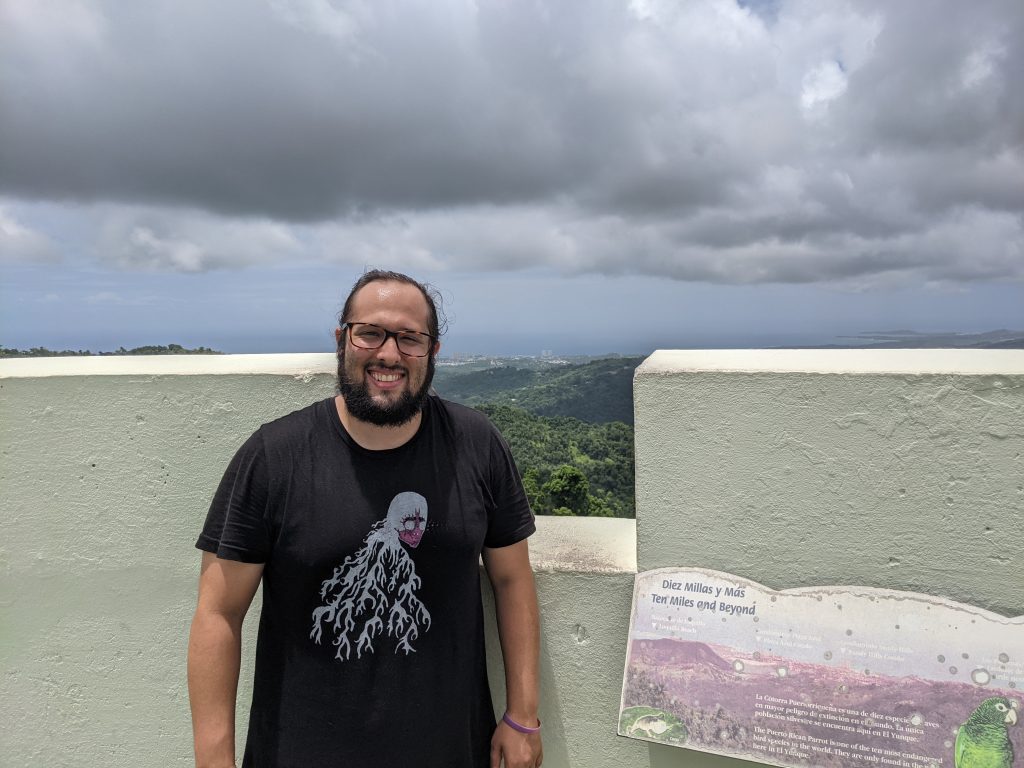Ian Seavey ‘23: The Culture of a Disaster
What turns a natural occurrence into a disaster? According to history Ph.D student Ian Seavey, the answer is human action.

By Brittney Nava ‘23
When natural disasters strike, onlookers often see the immediate impacts as the extent of the catastrophe; however, the aftermath can be just as pertinent, if not more.
For Florida-native, Ian Seavey, the lasting impacts of hurricanes have not only been a lived experience, but are also a key component of his doctoral research. After graduating from the University of Tampa, Seavey left his coastal hometown to pursue a Ph.D. in history at Texas A&M University.
Seavey’s research focuses on U.S. disaster relief in Puerto Rico. While politics and economics play a key role in this field, Seavey finds the cultural implications of disasters crucial as well.
“In communities where there’s frequent disasters, there’s often a before- and after-effect. You know, people remember where they were, people create art from the destruction — it becomes a part of the culture and folklore of the area,” Seavey noted.
Relief efforts, both locally and federally, play instrumental roles in shaping these oftentimes catastrophic shared experiences.
The first chapter of Seavey’s dissertation, “A Tale of Two Storms: US Army Disaster Relief in Puerto Rico and Texas” was recently published as an article. It focuses on federal responses to the 1899 San Ciriaco Hurricane in Puerto Rico and the 1900 Great Storm of Galveston.
“If you’re studying hurricanes or disasters in general, you kind of have to deal with the Galveston story in some way or another, but I found it interesting that these two storms are only a year apart and no one was talking about them in the same context even though the U.S. Army was involved in both efforts,” Seavey shared.
Both areas experienced similar impacts as a result of federal responses overlooking local perspectives
“In Puerto Rico, [the US Army] really excluded Puerto Rican voices and in Galveston, was steamrolling African American voices. It was the American military from the top down doing relief efforts with no cultural understanding of the local lay of the land,” Seavey explained.
Since these two particular storms, adjustments to federal disaster relief have been put into policy. Seavey is currently working on an article that traces U.S. disaster relief over the years, surveys the current state of the field, and provides insight for where the field should go in the future.
How has federal disaster relief changed over the years?
Prior to 1950, Seavey noted that disaster relief relied heavily on donations and fell mostly onto the shoulders of local and state governments.
“The federal government didn’t really get involved because [they] had to go through Congress, and that’s an arduous process. By that point, people have already died, homes are completely ruined and things like that.”
However, President Truman’s Federal Disaster Relief Act of 1950 gave the federal government a “beeline to provide relief,” as Seavey described it. The act allowed states and territories to request aid from the federal government, which the U.S. president has the power to approve or override. In 1979, the Federal Emergency Management Agency became the entity responsible for deploying this aid to areas declared a disaster.
Seavey added that after the widespread criticisms of federal relief efforts for Hurricane Katrina, the U.S. government and FEMA created the National Disaster Recovery Framework, which serves as a guiding document for FEMA’s responses to catastrophic disasters. The framework includes locally-responsive procedures that recognize underserved communities and communities that are historically Black or Hispanic.
“At least on paper things have gotten better, but there’s still a lot to be desired with FEMA. We still see in 2017, with Harvey, and Hurricane Maria in Puerto Rico as well, FEMA was not responding to the underserved communities well. Specifically, we found in our research over at The Bush School, the Vietnamese fishing communities on the coast of Texas received hardly any relief at all. We see the same thing with Puerto Rico, in general,” Seavey shared.
What is the ideal disaster relief?
According to Seavey, the general perspective toward disasters is what calls for adjustment.
“The lack of planning, the lack of relief efforts — those are what actually make the disaster a disaster,” Seavey said.
Rather than viewing hurricanes as one-off disruptions, Seavey sees them as inevitable occurrences that require long term and locally specific planning, especially in coastal areas where hurricanes are a part of the geographic culture.
“It’s difficult because FEMA is kind of like a ‘rainy day’ organization, but structural changes are key — investing in sustainable energy, sustainable infrastructure, things like that,” Seavey said.
Seavey also pointed to addressing poverty and the infrastructure in underserved communities as a form of long term disaster relief planning, given that these areas and communities tend to experience more exacerbated impacts.
More on Ian Seavey
When Seavey isn’t digging in the archives in Puerto Rico or analyzing disaster relief efforts, he spends time in music and sports. As a self proclaimed metal-head, he not only listens to the genre, but plays, and writes it with his local band, “Man is Myth.” He’s also co-founded the history department’s local softball team as a way to get people out of the office and enjoy some time outside.
Seavey is currently halfway through his Ph.D. and plans to graduate in the spring of 2024.
“Coming to [Texas A&M] was a no-brainer,” Seavey said. “I’ve really enjoyed it ever since.”
